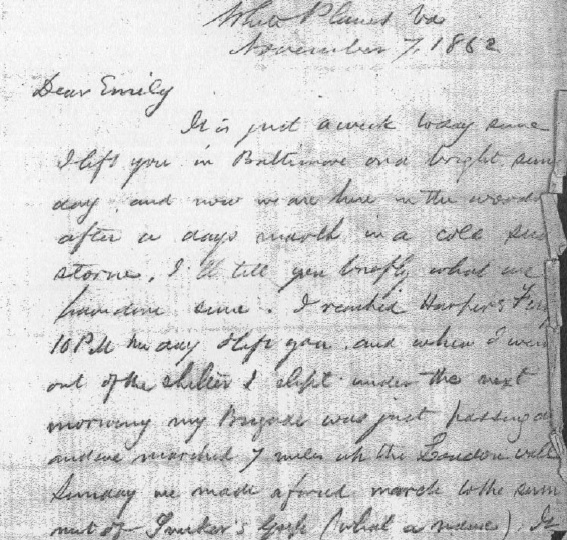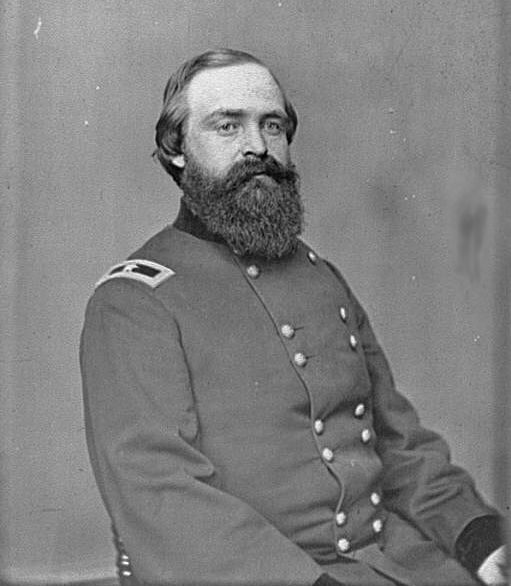The Downfall of a Federal Corps Commander: Warren-Sheridan and the Five Forks Controversy: Part One

It is a well-known fact that many historians live with the characters that they write about for many years. Delving into a major project often exposes us to an abundance of characters that are well known to the Civil War community as a whole. Some historians have made their entire career through the history world by focusing on one personality, or battle.
For more than a decade I have been exposed to one of the heroes of Gettysburg, Gouverneur K. Warren. Those even vaguely familiar with the battle usually know some version of the actions that took place on Little Round Top, or can identify Warren’s iconic statue atop the small Pennsylvania hill.
For the majority of the people I have come across in my career, their knowledge of G. K. Warren begins and ends on July 2nd, 1863. For me though, I have been exposed to Warren for the last fifteen or so years. I have spent countless hours reading his personal and military correspondence as I studied for the Gettysburg Guide test, authored Chancellorsville’s Forgotten Front, as well as writing my latest micro-tactical study of May 3rd at Chancellorsville.
Just like all those characters at Gettysburg, Warren had a life before and after the famous battle. With the 150th anniversary of the Battle of Five Forks upon us, I thought it would be fitting to write about the downfall of one Gettysburg’s most famous heroes. On April 1st, 1865, Warren’s career with the Army of the Potomac came to an abrupt and inglorious end. Warren was not felled like John Reynolds or John Sedgwick by a bullet on the field of battle; rather, Warren was relieved of command by the petty, deceitful, and downright reprehensible Philip H. Sheridan, while at the height of one of the most complete Federal victories in the Eastern Theater. As the Union and Confederate Armies made their way toward Appomattox, Warren was left behind in disgrace. Warren’s disgrace is all but forgotten due to the events of the two weeks following Five Forks. Warren fought for 14 years to have a court of inquiry called to clear his name. The New York native never left the Army, and finally had his day in court. What follows is the story of G. K. Warren, a very human and very flawed general, beyond the fields of Gettysburg.
*****
Gouverneur K. Warren was an odd duck to say the least. Warren was born in Cold Spring, New York on January 8th, 1830; the future brevet Major General of Volunteers was seemingly destined for an army career. His hometown was less than 10 miles from the United States Military Academy at West Point, and he was named after Gouverneur Kemble, a prominent politician and the man who founded the West Point Foundry.
At the age of 16 Warren officially entered West Point and graduated second in the class of 1850. Due to his high standing at graduation Gouv was allowed to pick a service branch of his choosing, and he chose the vaunted Engineers.

For the first nine or so years of his career Warren was in the western parts of the United States. His first posting took him west to New Orleans, where he met his new commanding officer Andrew A. Humphreys. As a young and brash army officer, Warren was quite the ladies man in the Creole City. Warren also took to his commanding officer. Both Warren and Humphreys were brilliant men, with very peevish personalities, thus the two of them foraged an enduring friendship.
His engineer duties also had the young Empire State officer following in some of the footsteps of Lewis and Clark, he mapped great expanses of the west including the Black Hills. He also searched for a viable route for the planned transcontinental railroad, an assignment that carried the backing of Secretary of War Jefferson Davis. The maps that Warren produced were both accurate wonderfully drawn, which is ironic, since his penmanship is absolutely horrendous.

In August of 1859 Warren returned to West Point, this time as a faculty member-specifically as a professor of mathematics.
With the outbreak of war, Warren obviously threw his hat in the ring for the Union. He accepted a commission as a lieutenant colonel of volunteers in the 5th New York Volunteer Infantry, better known as Duryee’s Zouaves. Future 5th Corps commander George Sykes said of the unit “I doubt whether it had an equal, and certainly no superior among all the regiments of the Army of the Potomac.”
The unit first saw action at the Battle of Big Bethal on June 10, 1861. Warren called the woefully mismanaged battle “an inglorious affair.” He assumed command of the regiment shortly after the battle and helped to hone the skill of the unit through drill.
The 5th New York fought valiantly at Gaines’s Mill. Receiving the brunt of an attack by Maxcy Gregg’s South Carolina brigade.
Warren was promoted to brigadier general he assumed command of an undersized brigade in the newly formed 5th Corps. He and his men performed outstanding service at Second Manassas and were the rear guard of the army when they evacuated the city of Fredericksburg in December 1862.
On February 4th, 1863, Warren assumed the role that he is most associated with from his wartime service, Chief Topographical Engineer of the Army of the Potomac. Warren was seen as a rising star within the army, and when Joseph Hooker revamped the army, Warren was just the sort of officer he was looking for; young, determined, and energetic.
Warren’s staff drew detailed maps of the Fredericksburg area. They moved up and down the Rappahannock River taking the river depths, while locating fords, and detailing what each ford could support (infantry, artillery, supply wagons, etc…). During the Chancellorsville Campaign, the young engineer was seemingly everywhere. From the opening shots of battle along the turnpike, to squawking in the ear of John Sedgwick, Warren made his presence known.
By late June Warren had caught the eye of George G. Meade, and when Meade assumed command of the army he initially offered the position of Chief-of-Staff to the New Yorker. Warren declined, claiming that he did not want to take the role in the midst of an active campaign.
Following Gettysburg there is ostensibly a black hole in the history of the Army of the Potomac, which most buffs, and many historians, ignore. It was in this time period that Warren ascended to corps command. With the death of John Reynolds, and the woundings of Winfield Scott Hancock and Daniel E. Sickles, Meade looked for competent corps commanders.

The vaunted 2nd Corps was in need of a soldier leader. The two ranking generals, William Hays and John Caldwell, were not corps leadership material. So Meade turned to Warren, who he had put up for promotion to major general. It was well known the Hancock wanted to come back to his corps as quickly as possible, thus Warren was supposed to just keep the seat warm for the corps recuperating commander.
Warren showed a flair for corps command. At the Battle of Bristoe Station, on October 14, 1863, he utilized the terrain of the field, and threw back a massed frontal assault by A. P. Hill’s Third Corps. During the Mine Run Campaign of November 27th-December 2nd, 1863, Meade drew up his plan of attack. The Federal’s would hit Lee’s forces on the Federal left. Warren would be given command of nearly one half of the Union Army. But at the last possible moment Warren balked at attacking the fortified enemy line. Shortly thereafter Meade withdrew his army from the field and ordered them into winter quarters.
In the spring of 1864, the infantry in the Army of the Potomac was consolidated from five infantry corps, to three. With the return of Winfield Scott Hancock, Warren was transferred from 2nd Corps to command of 5th Corps. He led the corps into the Wilderness, to Spotsylvania, North Anna, Cold Harbor, and the actions at the Siege of Petersburg. By March of 1865 Warren was the last man standing. All three of Meade’s other infantry corps commanders, who had entered the 1864 campaign under Grant and Meade (I am including the independent 9th Corps in this), were no longer with the Army of the Potomac. John Sedgwick was dead. Hancock, his vaunted 2nd Corps now a shell of its former self, was in the back water of the war. And Ambrose Burnside had been relieved after the debacle at the Crater. Yet, through it all, Warren remained at the head of 5th Corps.
Philip Sheridan was not the only commander rightfully to be accused of being “petty, deceitful and downright reprehensible” in relieving Warren. Grant was as much a party to–in fact, the primary source of–the vendetta against him.
Amanda,
You are correct in your assessment of Grant. He had written off Warren’s and his abilities long before. Warren could have been, and really should have been, relieved months prior to Five Forks. Grant gave Sheridan the silver bullet and he was more than willing to use it, right or wrong.
Grant always gave Sheridan carte blanche in his (Sheridan’s decisions) decisions. In Grant’s eyes Sheridan could never be wrong.
There was no vendetta. Warren was relieved because of his track record, his own bad habits, and because of some abominably foolish staff work by one of Meade’s junior staff officers.
This subject is being debated on Brett Schulte’s Petersburg blog.
James,
I agree that there was no vendetta. If Sheridan did not see something he liked he openly spoke out on the subject. I do think that the timing of his removal was wrong, I think he should have been relieved during the Overland campaign. Meade, Horace Porter, Theodore Lyman, and Grant all hit the nail on the head with Warren. To paraphrase them…they all had come to the conclusion that Warren had defect that could not be fixed. In my conclusion to the series I have pulled an interview with Chamberlain that describes Warren during and after the war. Essentially Chamberlain said that Warren was heinous in his treatment of other-including subordinates, but after the war that all changed, he was much more humble. I would have to imagine that losing his command brought his ego back down to earth. You can clearly see this shift in Warren’s writing’s as well.
Frankly, he should never have been a corps commander, IMO. He was temperamentally a staff man. The AotP would have been much better off if he and Humphreys had changed places in April, 1864.
Reblogged this on stormylntz and stuff.